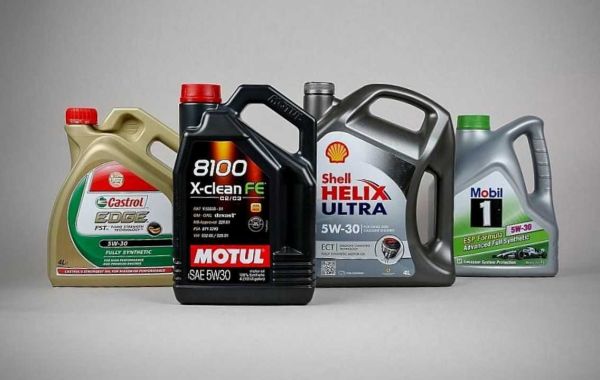Five types of fluids you should check in your car
Car maintenance.
To keep cars running smoothly and without malfunctions, it usually requires a large number of different types of regular maintenance of different systems of the car. Unfortunately, many of the routine works car owners cannot do on their own due to their lack of knowledge and experience. Fortunately for car owners, certain routine and routine works, which require skilled assistance, do not need to be carried out so often. But there is a certain number of routine inspections and work that any of the drivers may well do on their own. The simplest one is to regularly check different fluids in the car so that the car is in good condition.
Here are dear friends what fluids in the car you should check so that all systems in your car work without failures and breakdowns.
Most car fluid checks do not require your skill or any special knowledge. After all, it's not that difficult to lift the hood to check the necessary fluids contained there. By doing regular checks and scheduled replacement of various fluids you will keep your car in good condition and avoid costly breakdowns in the future.
In addition, independent replacement of the liquids in the car will allow you to avoid unfair attitude of car mechanics at service stations, where they often impose replacement of different liquids in the car, even if it is not necessary, and also use different methods of deception.
All you need for self-checking and replacing fluids is what to look for and where to look. Surely many motorists have heard often and repeatedly that the oil level must be checked regularly in order for the engine to work properly. Let's gentlemen elaborate on this and find out together what this means.
Keep in mind for yourself that each make and model of car differs from each other in its design, so the location of indicator ("dipstick") of oil in them is also different. And on this basis, our advice to motorists should be perceived as "universal instructions", which you can slightly modify by yourself according to the peculiarities of your available vehicle.
Engine oil
Most likely the very first thing you learned about your first car is that it is necessary to check the oil level in the engine and periodically change it. This work needs to be done in most cars that have, as a rule, the ability to check the fluid level in the engine.
In most cars to check the oil level, you must first stop the engine, then open the hood, find the dipstick to be pulled out, well and do not forget to wipe it. After that, it is necessary to insert this clean dipstick back into the engine block for a short time, and then take it out again to check and check the oil level. If the oil level does not meet the minimum allowed value, it is necessary to refill the engine oil to the normal level. Keep in mind friends that the older the car, the more often you will have to topping up the oil in the engine. If your car has started to burn a large amount of oil, you need to go to an auto shop for engine diagnostics.
How Often to Check the Oil in the Engine: Once upon a time car manufacturers recommended checking the oil level in the engine specifically every time you filled up at a gas station. These days, such frequent checks are no longer necessary in modern cars. Just checking once a month is enough.
How often should I change the oil in the engine: It depends on the automaker, as well as on the manner of driving, on the climatic conditions of the vehicle, on the year of production of this vehicle and many other things. Some motorists say that it is necessary to change the oil every 5,000 km or every 6 months. And someone on the contrary says that it's necessary to replace the oil in the engine every 15.000 - 20.000 km. Well, to find out exactly how often you need to change the oil in your engine, you need to refer to the manual of your car (or to the service book), where the manufacturer recommends the periodicity of oil replacement.
Gearbox Oil
Your transmission does a very complex job of transmitting engine torque through it to the wheel drive. Thanks to this gearbox, the car accelerates quickly and at the same time smoothly. In many cars, you can also check the oil in the transmission yourself, just as you check the oil in the engine. The difference between this transmission oil check and the engine oil check is that the engine must be running at this time.
Unlike engine oil, transmission oil is inside a closed system, so the level of this oil in the box cannot be low.
If the oil level in the transmission turned out to be low, without adding oil to the box contact a specialized car service center directly with this problem to diagnose depressurization of the box and oil leakage from it. During this check the oil in the box is checked: the color of the fluid, the viscosity and its smell.
The oil in the box should be red in color and not contain any burnt smell. If the fluid is brown in color and smells burnt, you need to change the oil in the box.
How often should you check the oil in the box: Monthly.
How often you should change the oil in the box: This depends on the type, make, and model of the car. It also depends on the type of transmission. But for most vehicles, the frequency of transmission oil changes typically ranges from 80,000 to 160,000k miles.
Coolant (Antifreeze)
As the name of the coolant itself suggests, otherwise known as antifreeze, it cools the engine of a car from specific overheating. If the coolant level is below the allowable level, it is likely that your car will overheat. The coolant is inside the radiator. You can check the level by removing the radiator cap, or the same cap where the antifreeze is (depending on the brand and model of the car the cap is in different locations under the hood). Remember dear motorists that such a check of the antifreeze must be done only when the engine is cold and must be turned off. If the fluid level in the tank is low, you need to refill the antifreeze to the required minimum level.
How often the antifreeze level should be checked: At least twice a year. In the spring and fall. We recommend friends to check the coolant level every time you open the hood of the car. It is not difficult at all, but it will help to avoid unexpected fluid leakage as a result of depressurization of engine cooling system.
How often should you change the antifreeze: Every 2 to 3 years.
Brake fluid
Just like the transmission, this car's brake fluid is inside a closed loop system, so the level of this fluid in the brake system should never be low. However, checking the level of this fluid is necessary to avoid unexpected breakdowns of the brake system itself. A container of brake fluid is located right under the hood of the car. Basically, the tank with this fluid is located on the left side of the car. To check the level of the fluid you just need to look at the side of the available level. The color of the brake fluid is also checked. It should be a golden color. If the color has turned brown or even darker, then that brake fluid needs to be replaced.
How Often to Check the Brake Fluid: Every time you change the oil in the engine.
How often should the brake fluid be changed: Every 2 years.
Power Steering Fluid
Your car's power steering fluid helps you make that steering wheel feel soft and easy. When the power steering fluid level gets low, you may hear the steering wheel squeak or other strange noises. To check the power fluid level, you need to find a special reservoir under the hood where this very fluid is located. Usually to check the level of the power steering fluid, you just need to look inside the available reservoir. As you know, the level of fluid in the power booster usually does not drop to the minimum values. So remember friends, if you find a low level in the reservoir where the power steering fluid is filled in, you need to have it diagnosed at a car service center to specifically identify a possible leak of this fluid from the steering system.
How often you should check the power steering fluid: Once a month.
How often should the power steering fluid be changed: At least every 80,000 km or never. Usually car manufacturers recommend not changing the power steering fluid until, for some reason, the fluid is below the prescribed level. But not all cars are nonreplaceable power fluid. Manufacturers of many cars recommend changing this fluid every 80,000 km. Carefully read your car's owner's manual to find out for yourself how often to change the power steering fluid in your car.
Source : https://thetrucks.us/







